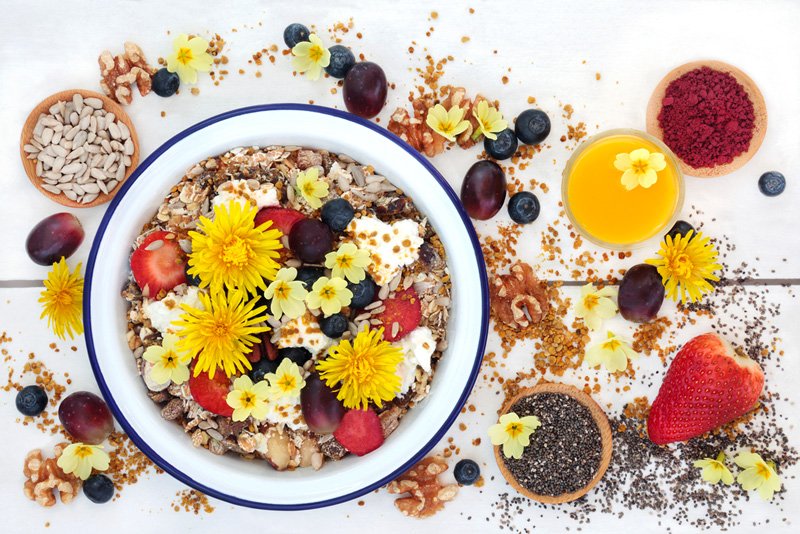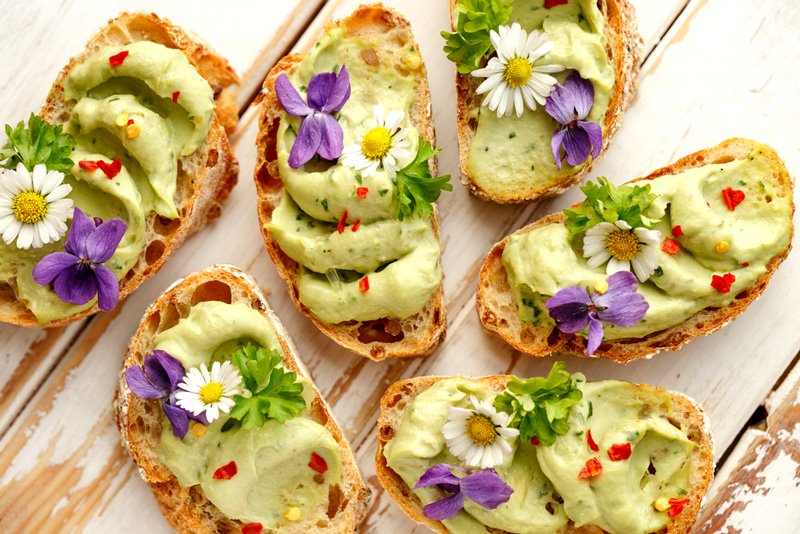Flowers have been admired for their beauty and fragrance since time immemorial. They were used by our ancestors for everything from decorating homes to occupying pride of place at important rituals such as funerals and marriage. Apparently, some things never change!
Calendula, a member of the marigold family, was a favourite with the Ancient Romans who used it with vinegar as a seasoning for meat dishes. They also used roses and violets in their food as delicacies, while the dandelion is mentioned in the Bible.
Records going back as far as 140 B.C show ancient civilisations recognised the culinary and nutritional value of edible flowers. Indeed, it was Ancient Greek, Roman, and Chinese herbalists who first realised that flowers were more than just pretty to look at; they're good for us as well.

Recent years have seen edible flowers back on our plates, possibly as a consequence of the “grow your own food” movement and demand for organic food in cafes and restaurants. Dishes are now adorned with edible flowers, embellishing a range of foods and decorating social media feeds.
But just how good are they for us and how easily can they be incorporated into our diet and grown in our own backyards?
Let’s take the last question first: How can they be grown in our gardens? Well, chances are you're already growing edible flowers, without being aware of it. Many of the pesky weeds that invade our flower beds and lawns have flowers that are not only nutritious but also taste good.
Dandelion
The ubiquitous dandelion (aka lion’s tooth), which has long been responsible for gardeners’ sore backs in Western culture, is one example. Changing our thinking from treating them as weeds, and therefore seeing them as a nuisance and an eyesore, to using them as a valuable food source does take time. Particularly for long-suffering gardeners so used to pulling them out of the ground year after year. Perhaps this is due to our dedication, some would say obsession, in our society with a clean, weed-free lawn? Every spring, dedicated gardeners spend time, energy and money to eradicate the dandelion from lawns, flower beds and vegetable gardens.
However, cuisine in Asian countries (and some European countries) have long embraced the humble lawn weed. All parts of the dandelion may be consumed safely, including the familiar yellow flowers. Take a look at this article for some great ideas on how to incorporate dandelion greens into your meals.
The plant abounds in nutrients due to its long taproot, which brings goodness up from deep in the soil. As a result, the flowers contain an abundance of polyphenols and antioxidants.

Dandelions can be made into a juice or sprinkled through a salad, adding colour and vitality as well as other important vitamins, minerals, and antioxidants. The yellow petals are versatile in cooking, with historical uses including pancakes and Middle Eastern cuisine, as well as in preparation of alcohol such as schnapps.
The great news is you don’t need to cultivate the dandelion, it’s everywhere in the warmer weather!
Marigold
There was a time, during the Great Depression of the thirties (and during other economic downturns in our history), when Australians had to supplement their meagre diets with their own vegetables to save money. One of the ways to supplement people’s diets and provide much-needed nutrients was to eat marigold flowers, as they are so easy to grow.
Also known as the “poor man’s saffron” marigolds add a special pungency and colour to any dish and can be used through salads, as a garnish, or in baking (or un-baking). Try this Raw Calendula (Marigold) Beauty Bar for a delicious snack that's also good for your skin.
Importantly, Marigolds contain flavonoids which help protect against cell damage.

Start marigold seeds indoors six to eight weeks before the last frosts and plant out seedlings as the weather warms. Marigolds will self-seed so, under the right conditions, you can have your crop of delightful and nutritious marigolds year after year!
Squash Blossom
If you’re a vegetable gardener, you will know summer brings with it a surfeit of squash. Zucchinis are easy to grow in the warmer months, and so productive that most of us have had our fill of the fruit well before the growing season ends with the frosts.
For something a bit different, give this Greek-style Stuffed Zuchini Flowers dish a go for dinner. Squash blossoms are delicious and contain a range of essential minerals, such as zinc, magnesium, manganese, potassium, copper, and calcium, as well as vitamins A, C, E, and K.

They like the warmer weather and won’t tolerate frosts; you can either grow them undercover until the warmer weather arrives or plant as seeds in compost-rich soil in late spring or early summer, depending on your climate zone. Give them plenty of space in a sunny, protected spot and they’ll thrive. Keep the water up to them but don’t water on the leaves as this will encourage mildew.

Growing edible flowers such as the above can be an easily-grown and welcome source of vitamins and minerals. However, start small. Use flowers judiciously so they don’t overpower the dish. Try a handful of the petals first, then add more as your taste adjusts.
Some important tips to remember:
- Make sure you properly identify the flowers prior to eating them.
- Many edible flowers look VERY similar to species that are toxic to humans.
- Please check a reputable book or internet site prior to consuming them.
- It's also advisable to ensure they haven't been sprayed with chemicals.
If purchasing edible flowers, use the same caution you would when shopping for vegetables; go for those organically grown flowers that are fresh, show no signs of decay (where petals are sticky or moist) and retain their colour.
Do you already grow or eat edible flowers and have a favourite?
Share your thoughts and best recipes in the comments below, we'd love to hear from you!

Love Health?
From recipes, trends and discounts, expect great things via email this month.
More Great Reads!

Behind The Brand: Antipodes
Recipes We Love!

Clever Cookies












